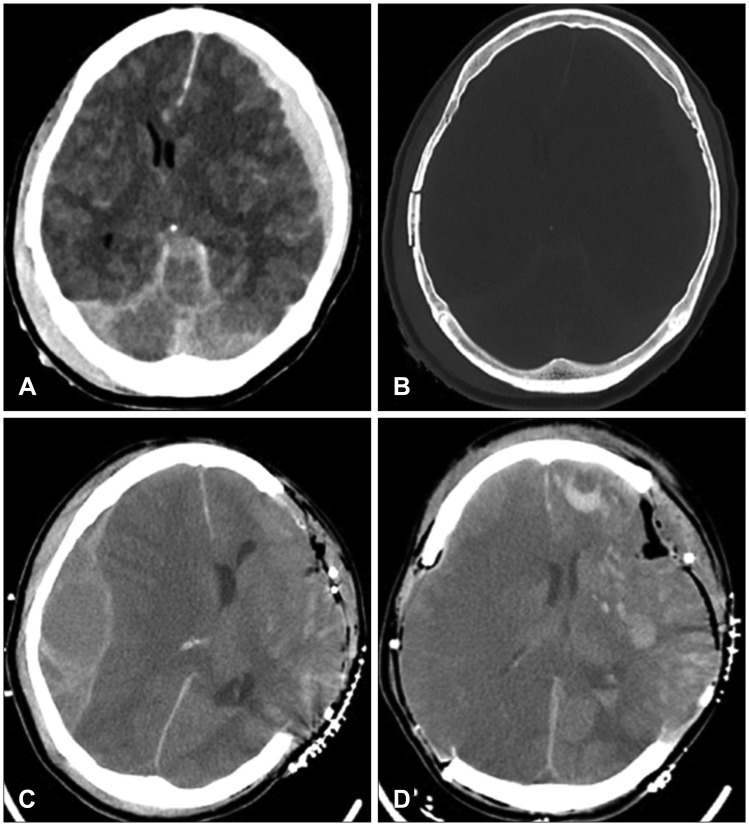Korean J Neurotrauma.
2017 Oct;13(2):108-112. 10.13004/kjnt.2017.13.2.108.
Clinical Features and Outcomes of Bilateral Decompression Surgery for Immediate Contralateral Hematoma after Craniectomy Following Acute Subdural Hematoma
- Affiliations
-
- 1Department of Neurosurgery, Gachon University, Gil Medical Center, Incheon, Korea. samddal@gilhospital.com
- KMID: 2394543
- DOI: http://doi.org/10.13004/kjnt.2017.13.2.108
Abstract
OBJECTIVE
Immediate contralateral epidural hematoma (EDH) and traumatic intracerebral hematoma (T-ICH) after craniectomy for traumatic subdural hematoma (SDH) are rare but devastating post-operative complications. Their clinical features and outcomes are not well studied. In this report, we present the clinical features and outcomes of immediate contralateral acute hematoma cases requiring a second operation.
METHODS
This study includes 10 cases of immediate contralateral EDH and T-ICH following bilateral craniectomy for the evacuation of traumatic SDH and contralateral hematoma between 2004 and 2015. Their medical records and radiographic findings were reviewed and analyzed retrospectively.
RESULTS
Ten of the 528 patients (1.89%) who underwent craniectomy for the evacuation of traumatic SDH developed post-operative EDH (n=5), T-ICH (n=5). The trauma was caused by a fall in 5 patients and by a traffic accident in 5 patients. The patients who suffered trauma due to pedestrian accidents died. Seven patients had a low admission Glasgow Coma Scale (GCS; GCS≤8) score in the preoperative state (average admission GCS, 7.7; average discharge GCS, 3.4; and average discharge Glasgow Outcome Scale, 2.0). Severe intra-operative brain swelling was noted in all patients, while skull fracture was observed in 8. Multiple associated injuries and medication for heart disease were characteristic of patients who died.
CONCLUSION
The prognosis of delayed contralateral hematoma was very poor. Multiple associated injuries, past medical history and traffic accidents, especially pedestrians were seemed to be associated with higher mortality rates. Finally, contralateral skull fractures can indicate high risk of delayed contralateral acute intracranial hematoma.
MeSH Terms
Figure
Reference
-
1. Borovich B, Braun J, Guilburd JN, Zaaroor M, Michich M, Levy L, et al. Delayed onset of traumatic extradural hematoma. J Neurosurg. 1985; 63:30–34. PMID: 4009271.
Article2. Feuerman T, Wackym PA, Gade GF, Lanman T, Becker D. Intraoperative development of contralateral epidural hematoma during evacuation of traumatic extraaxial hematoma. Neurosurgery. 1988; 23:480–484. PMID: 3059212.
Article3. Gong J, Li Q, Cao Y, Zheng X, Ma Y, Zhan R. Serial attacks: Contralateral hematoma secondary to decompressive craniectomy for traumatic brain injury led to posttraumatic cerebral infarction. J Craniofac Surg. 2016; 27:e159–e162. PMID: 26854773.4. Gusmão SN, Pittella JE. Acute subdural hematoma and diffuse axonal injury in fatal road traffic accident victims: a clinico-pathological study of 15 patients. Arq Neuropsiquiatr. 2003; 61:746–750. PMID: 14595476.
Article5. Kompheak H, Hwang SC, Kim DS, Shin DS, Kim BT. Surgery for bilateral large intracranial traumatic hematomas: evacuation in a single session. J Korean Neurosurg Soc. 2014; 55:348–352. PMID: 25237431.
Article6. Maas AI, Hukkelhoven CW, Marshall LF, Steyerberg EW. Prediction of outcome in traumatic brain injury with computed tomographic characteristics: a comparison between the computed tomographic classification and combinations of computed tomographic predictors. Neurosurgery. 2005; 57:1173–1182. PMID: 16331165.
Article7. Majdan M, Mauritz W, Wilbacher I, Janciak I, Brazinova A, Rusnak M, et al. Traumatic brain injuries caused by traffic accidents in five European countries: outcome and public health consequences. Eur J Public Health. 2013; 23:682–687. PMID: 22689382.
Article8. Matsuno A, Katayama H, Wada H, Morikawa K, Tanaka K, Tanaka H, et al. Significance of consecutive bilateral surgeries for patients with acute subdural hematoma who develop contralateral acute epi- or subdural hematoma. Surg Neurol. 2003; 60:23–30. PMID: 12865006.
Article9. Shen J, Pan JW, Fan ZX, Zhou YQ, Chen Z, Zhan RY. Surgery for contralateral acute epidural hematoma following acute subdural hematoma evacuation: five new cases and a short literature review. Acta Neurochir (Wien). 2013; 155:335–341. PMID: 23238942.
Article10. Su TM, Lan CM, Lee TH, Hsu SW, Lu CH. Risk factors for the development of contralateral epidural hematoma following decompressive craniectomy in patients with calvarial skull fracture contralateral to the craniectomy site. World Neurosurg. 2016; 89:223–229. PMID: 26875660.
Article11. Su TM, Lee TH, Chen WF, Lee TC, Cheng CH. Contralateral acute epidural hematoma after decompressive surgery of acute subdural hematoma: clinical features and outcome. J Trauma. 2008; 65:1298–1302. PMID: 19077617.
Article
- Full Text Links
- Actions
-
Cited
- CITED
-
- Close
- Share
- Similar articles
-
- Intraoperative Development of Contralateral Subdural Hematoma during Evacuation of Acute Subdural Hematoma: Case Report
- Bilateral Acute Subdural Hematoma Following Evacuation of Chronic Subdural Hematoma
- Postoperative Contralateral Supra- and Infratentorial Acute Epidural Hematoma after Decompressive Surgery for an Acute Subdural Hematoma: A Case Report
- "Contralateral" Acute Subdural and Intracerebral Hemorrhage Occurring Simultaneously after Evacuation of Huge Chronic Subdural Hematoma
- Paradoxical Herniation after Decompressive Craniectomy for Acute Subdural Hematoma


